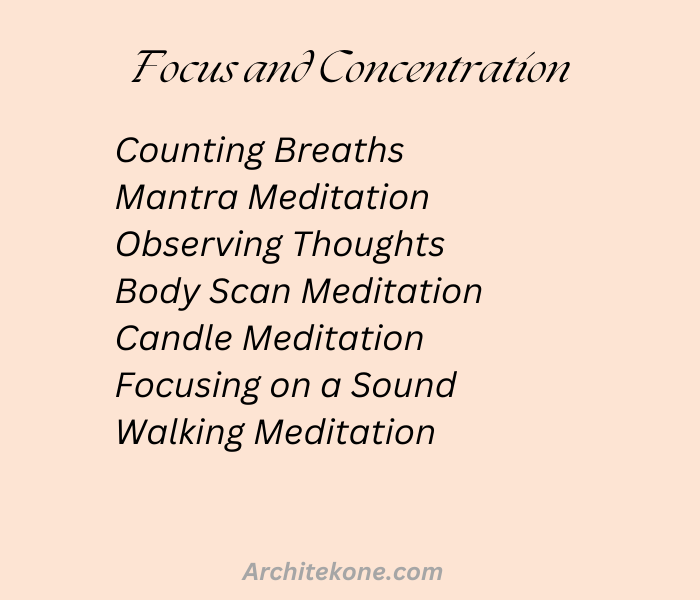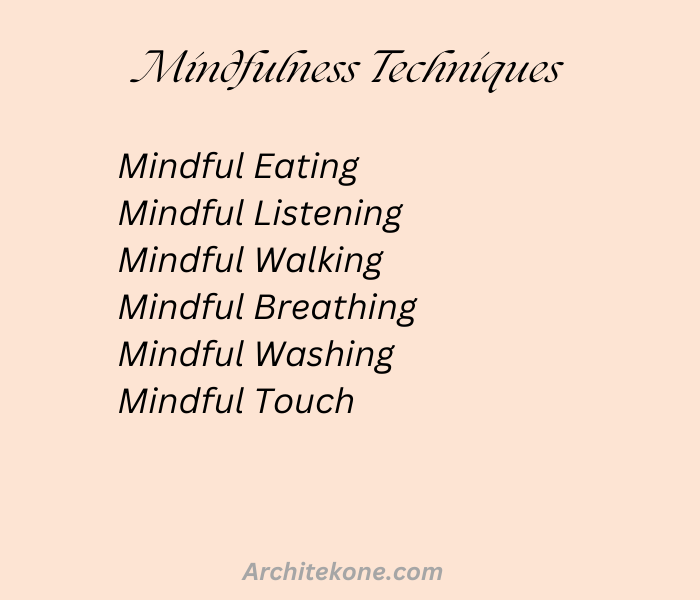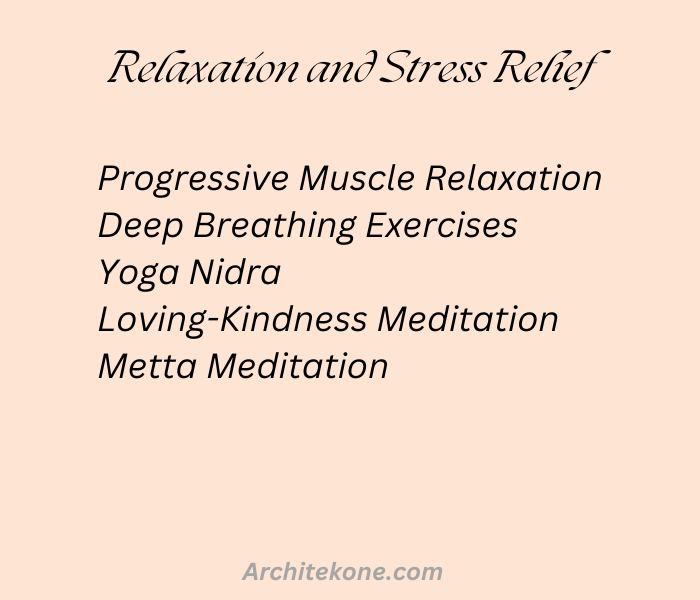Meditation, often perceived as complex and elusive, is actually a simple yet profound practice accessible to everyone. This guide offers a diverse collection of 45 meditation techniques tailored for beginners, providing a gentle introduction to the world of mindfulness and inner peace.
Whether you’re seeking stress relief, improved focus, or a deeper connection with yourself, there’s a meditation technique here to suit your needs and preferences. From guided visualizations to body scans, from breath awareness to mantra repetition, these techniques offer a variety of approaches to help you cultivate calm and clarity.
Embark on this exploration with an open mind and a willingness to experiment. Remember, the goal isn’t perfection but progress. With consistent practice, you’ll discover the transformative power of meditation and its ability to enrich your life in countless ways.
Focus and Concentration

Counting Breaths
This simple yet powerful technique involves directing your attention to the rhythm of your breath. Inhale deeply, counting to four, hold for four, and exhale for four. This rhythmic focus anchors your mind, reducing mental chatter. Regular practice can enhance concentration and calm the nervous system.
Mantra Meditation
A mantra is a word, sound, or phrase repeated mentally or vocally to aid concentration. Choose a mantra that resonates with you, such as “peace,” “love,” or “calm.” Repeat it silently or aloud, allowing your mind to focus solely on the mantra, gradually silencing other thoughts.
Observing Thoughts
This meditation technique involves observing your thoughts without judgment. Notice the thoughts that arise, without getting caught up in them. This practice increases awareness of mental patterns and helps you develop the ability to disengage from distracting thoughts.
Body Scan Meditation
Directing attention to different parts of your body can enhance focus and body awareness. Start by focusing on your feet, gradually moving upward, noticing sensations without judgment. This practice helps ground you in the present moment and reduces mental and physical tension.
Candle Meditation
Gaze softly at a candle flame, using it as a focal point. Observe the flicker of the flame, the color of the wax, and the sensations in your body. This meditation cultivates sustained attention and mindfulness.
Focusing on a Sound
Select a specific sound, such as the ticking of a clock or the sound of rain. Direct your attention solely to this sound, noticing its nuances and qualities. This practice improves auditory focus and concentration.
Walking Meditation
Mindful walking involves paying close attention to the physical sensations of walking. Focus on the movement of your feet, the rhythm of your breath, and the environment around you. This meditation enhances body awareness, grounding, and present-moment focus.
Mindfulness Techniques

Mindful Eating
Transform mealtime into a mindful experience. Engage all your senses by slowly savoring each bite. Pay attention to the taste, texture, and aroma of your food. Notice the satisfaction and fullness cues your body sends. By eating mindfully, you cultivate a healthier relationship with food and enhance your overall well-being.
Mindful Listening
Give your undivided attention to the speaker. Focus on understanding their perspective without interrupting. Observe your own thoughts and emotions, but resist the urge to formulate responses while the other person is speaking. Practice active listening by maintaining eye contact and providing verbal and nonverbal cues to show engagement.
Mindful Walking
Turn your daily walks into opportunities for mindfulness. Pay attention to the sensations of your feet on the ground, the rhythm of your breath, and the sights, sounds, and smells around you. Let go of distractions and simply be present in the moment. Mindful walking can reduce stress and improve overall well-being.
Mindful Breathing
Anchor yourself in the present moment by focusing on your breath. Observe the sensation of the air entering and leaving your body. Notice the rise and fall of your chest or abdomen. When your mind wanders, gently bring your attention back to your breath. Regular mindful breathing practice can promote relaxation and clarity.
Mindful Washing
Transform routine tasks into mindful experiences. Pay attention to the sensations of the water on your skin, the scent of the soap, and the feeling of cleanliness. Notice the process of washing without rushing. Mindful washing can enhance your appreciation for simple pleasures and boost your mood.
Mindful Touch
Engage with the world through mindful touch. Pay attention to the textures, temperatures, and sensations you experience. Whether it’s holding hands, hugging, or simply touching an object, be fully present in the moment. Mindful touch can deepen connections with others and enhance your sensory awareness.
Visualization and Imagery

Guided Imagery
Guided imagery is a structured visualization process led by a trained professional or audio recording. Participants are guided through a series of mental images designed to evoke specific emotions or experiences. This technique is often used in relaxation, stress management, pain management, and therapeutic settings. By following the guidance, individuals can deepen their relaxation response and promote a sense of calm and focus.
Nature Visualization
Connecting with nature has a profound impact on mental and emotional health. Nature visualization involves creating mental images of peaceful natural environments, such as forests, beaches, or mountains. By immersing oneself in these serene landscapes, individuals can reduce stress, anxiety, and negative emotions. This practice encourages a sense of connection to the natural world and promotes feelings of tranquility and rejuvenation.
Happy Place Visualization
A happy place visualization is a personal mental retreat where individuals can escape from stress and negative thoughts. By vividly imagining a place that evokes joy, happiness, and relaxation, individuals can create a mental sanctuary. This technique can be used as a coping mechanism during challenging times or as a tool for relaxation and stress reduction. Regular practice can strengthen the mind-body connection and enhance overall well-being.
Visualization of Healing
Visualization can be a powerful tool for promoting physical and emotional healing. By creating mental images of the body repairing itself and restoring balance, individuals can support the body’s natural healing processes. This technique can be used in conjunction with traditional medical treatments to enhance recovery and reduce pain. Visualization of healing encourages a positive mindset and promotes a sense of control over one’s health.
Body Energy Visualization
Body energy visualization involves focusing attention on the flow of energy within the body. By imagining energy centers or chakras, individuals can cultivate a sense of balance and well-being. This technique can enhance relaxation, improve circulation, and promote overall vitality. By visualizing energy moving freely through the body, individuals can release physical and emotional tension, leading to a greater sense of harmony and vitality.
Relaxation and Stress Relief

Progressive Muscle Relaxation
This technique involves systematically tensing and relaxing different muscle groups. By focusing on releasing physical tension, you can also alleviate mental stress. Begin by tensing the muscles in your feet, holding for a few seconds, then releasing. Gradually work your way up the body, tensing and relaxing each muscle group until you reach your head.
Deep Breathing Exercises
Deep breathing is a simple yet powerful technique for calming the mind and body. By taking slow, deep breaths, you activate the parasympathetic nervous system, which promotes relaxation. Focus on inhaling deeply through your nose, holding for a few seconds, and exhaling slowly through your mouth.
Yoga Nidra
Often described as “yogic sleep,” Yoga Nidra is a guided relaxation technique that promotes deep relaxation and stress reduction. It involves lying down comfortably and systematically focusing on different parts of the body while maintaining awareness. Regular practice can help alleviate insomnia, anxiety, and fatigue.
Loving-Kindness Meditation
This meditation practice cultivates feelings of warmth, compassion, and kindness towards oneself and others. By focusing on sending well wishes to yourself and those around you, you can develop a greater sense of peace and inner calm. Regular practice can enhance empathy, reduce stress, and improve relationships.
Metta Meditation
Similar to Loving-Kindness Meditation, Metta Meditation focuses on cultivating loving-kindness and compassion. However, it often involves directing these positive emotions towards oneself first, building a strong foundation of self-compassion before extending it to others. This practice can foster resilience, reduce self-criticism, and increase overall well-being.
Spiritual and Philosophical

Chakra Meditation
This meditative practice focuses on balancing and harmonizing the body’s energy centers, known as chakras. By directing attention to each chakra, individuals can address physical, emotional, and spiritual imbalances. Through visualization, breathing techniques, and mantras, practitioners aim to unblock energy flow and promote overall well-being.
Grounding Meditation
Grounding meditation is a technique that connects individuals to the earth’s energy, fostering a sense of stability and security. By visualizing roots extending from the body into the ground, practitioners can release stress and anxiety while cultivating a deeper connection to nature. This meditation promotes a grounded presence and a clear mind.
Transcendental Meditation
Transcendental Meditation (TM) involves the use of a specific mantra to transcend conscious thought and reach a state of pure consciousness. Practitioners sit comfortably with eyes closed and mentally repeat the mantra, allowing the mind to settle into a deep state of relaxation and inner peace. TM aims to reduce stress, improve focus, and enhance overall well-being.
Zen Meditation
Zen meditation, originating from Buddhism, emphasizes mindfulness and awareness of the present moment. By focusing on the breath or a specific object, practitioners cultivate a state of non-judgmental observation. This practice aims to develop insight, reduce mental clutter, and foster a sense of inner peace and clarity.
Vipassana Meditation
Vipassana meditation is a form of mindfulness meditation that involves observing the body’s sensations without judgment. By cultivating awareness of physical and mental phenomena, practitioners develop insight into the nature of reality and the workings of the mind. Vipassana aims to reduce suffering, cultivate equanimity, and promote liberation from mental and emotional patterns.
Creative and Expressive

Art Meditation
Immerse yourself in the world of colors, shapes, and textures. Allow your hands to move freely, guided by intuition rather than expectation. Whether you prefer painting, drawing, sculpting, or collage, let the creative process be your meditation. Explore different mediums and styles to discover your artistic voice.
Music Meditation
Harness the power of sound to transport your mind to a state of tranquility. Listen attentively to the nuances of your chosen music, focusing on the melodies, harmonies, and rhythms. You can also create your own music, experimenting with instruments or vocal improvisation. Let the music wash over you, inducing a deep sense of relaxation and inner peace.
Dance Meditation
Move your body with intention and freedom. Let go of inhibitions as you explore different dance styles and rhythms. Feel the music in your bones and allow your body to express itself naturally. Dance meditation can be a powerful way to release tension, connect with your physicality, and cultivate a sense of joy.
Writing Meditation
Unleash your thoughts and emotions through the written word. Set a timer and write freely without judgment. Explore your inner world, capturing your experiences, dreams, and aspirations. Writing meditation can be a cathartic process, helping you gain clarity and perspective.
Nature Meditation
Connect with the natural world through mindful observation. Immerse yourself in a serene outdoor setting, focusing on the sights, sounds, and sensations around you. Observe the intricate details of plants, animals, and the sky. Let nature’s beauty and tranquility soothe your mind and spirit.
Other Techniques

Breath Awareness Meditation
Focus on the sensation of your breath as it enters and leaves your body. Observe the rise and fall of your chest or abdomen without judgment. When your mind wanders, gently bring it back to the breath. This practice anchors you in the present moment and reduces anxiety.
Loving-Kindness and Compassion Meditation
Cultivate feelings of warmth, kindness, and compassion towards yourself and others. Begin by sending well-wishes to yourself, then expand to loved ones, acquaintances, and eventually all beings. This practice fosters empathy, reduces stress, and enhances overall well-being.
Forgiveness Meditation
Let go of resentment and anger by practicing forgiveness. Visualize releasing negative emotions associated with past hurts. Focus on cultivating understanding and compassion towards those who have wronged you. Forgiveness meditation promotes inner peace and emotional healing.
Gratitude Meditation
Reflect on the things you are grateful for in your life. This practice shifts your focus towards positivity and abundance. By appreciating the present moment, you cultivate a more optimistic outlook and increased life satisfaction.
Self-Inquiry Meditation
Explore your inner world by asking yourself questions about your thoughts, feelings, and beliefs. This practice fosters self-awareness and helps you understand your motivations and patterns. By examining your inner landscape, you gain insights into your true nature.
Mindfulness of the Present Moment
Bring your attention to the current experience without judgment. Observe your senses, thoughts, and emotions without getting caught up in them. This practice helps reduce stress, improve focus, and enhance overall well-being.
Observing the Mind
Witness your thoughts and emotions as they arise and pass without engaging with them. This practice develops detachment and clarity. By observing your mental activity, you gain insight into your thought patterns and can break free from negative thought cycles.
Letting Go Meditation
Letting go meditation is a practice designed to release stress, anxiety, and emotional baggage. It involves cultivating a mindset of non-attachment and acceptance. By focusing on the present moment, you learn to let go of past regrets and future worries. Techniques include deep breathing, body scans, and visualization to promote relaxation and release tension. The goal is to cultivate a sense of peace and inner freedom.
Open Monitoring Meditation
Open monitoring meditation, also known as mindfulness meditation, involves observing thoughts, feelings, and sensations without judgment. It’s about bringing awareness to the present moment without getting caught up in mental chatter. By practicing regular open monitoring, you can develop a greater sense of clarity, focus, and emotional balance.
Sitting Meditation
Sitting meditation is a classic form of meditation where you adopt a seated posture, typically with crossed legs or in a chair. The focus is on maintaining awareness of the breath and bodily sensations. Regular practice can lead to increased concentration, reduced stress, and a deeper connection with oneself.
Standing Meditation
Standing meditation involves maintaining a still, upright posture while focusing on the breath and body sensations. This practice can improve balance, posture, and body awareness. It also helps to cultivate mindfulness and presence in daily activities.
Lying Down Meditation
Lying down meditation is a gentle and restorative practice that can be beneficial for relaxation and stress reduction. By focusing on the body and breath while in a reclined position, you can release physical tension and mental chatter. This form of meditation is particularly helpful for those with physical discomfort or insomnia.
Final Thoughts
Congratulations on taking the first step towards a more mindful and peaceful life! This exploration of meditation techniques has offered a glimpse into the vast world of possibilities available to you. Remember, the most important aspect of meditation is consistency. Even a few minutes of daily practice can yield significant benefits.
As you continue your meditation journey, experiment with different techniques to find what resonates with you. Don’t be afraid to adjust your practice as your needs and experiences evolve. Most importantly, approach meditation with patience, kindness, and curiosity.
By incorporating meditation into your daily routine, you’ll cultivate a greater sense of calm, clarity, and well-being. Enjoy the process and embrace the transformative power of mindfulness.

